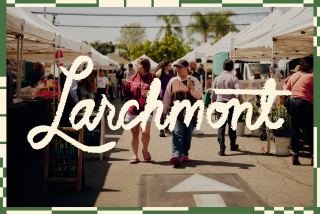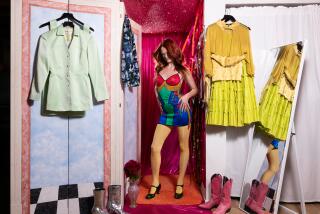Shirley, the button pusher
F&S; Fabrics is an L.A. institution and an anomaly, an independent dry goods store that has occupied the same corner of Pico Boulevard near Rancho Park for almost 50 years. Shirley Savoy has ruled the button counter at F&S; for as long as most of her customers can remember -- since the late ‘80s, in fact. A thin and strong and unfailingly energetic woman, she stopped counting birthdays after her 39th, and her coyness has made speculating on her true age a running gag among her co-workers. Her brown eyes roll when the subject of how old she is comes up. “Oh, honey,” she says, “what you want to know that for?”
Buttons, ribbon and other notions have always been sold at F&S;, but the epoch of Shirley has been marked by expansion, buttons spreading over the shop’s front room like kudzu. Now hundreds of narrow, deep cardboard boxes are stacked on shelves from floor to ceiling, their sample-studded ends facing out, forming a mad mosaic. The buttons are made of horn and wood, crystal, rhinestone, jet, metal, tortoiseshell, velvet, leather or silk cord. A display of knots of twisted gold in four sizes rests just above a school of colored resin fish perfect for a child’s sweater. One shelf down and five boxes to the left, light bounces off delicate balls of etched glass that could help a mundane jacket masquerade as a vintage treasure.
Boxes continue around a corner, threatening to take over the adjacent wall. Soon they will, Savoy says, as if the manifest destiny of her button empire cannot be denied. For she isn’t just the button queen of West Los Angeles, the button maven or a mere button tyrant. She’s the button Nazi, able to inspire the same sort of fear and awe as the soup Nazi, the merciless chowder and mulligatawny despot made famous in a memorable “Seinfeld” episode. His customers either followed strict ordering procedures or they were told, “No soup for you!”
Like the soup Nazi, Savoy has her rules. If you’re looking for buttons for a jacket or a hand-knitted sweater, for example, bring it in with you, for heaven’s sake, or she might send you home to fetch it. “I spend so much time helping people, and if they don’t have the garment with them, they’re going to get home and the buttons won’t look right,” she explains. “I knooow they’re not going to look right.” When Savoy makes a point, she often strings her syllables out for emphasis, the way she does when she purrs about how cree-ay-tive she can be if you will just trust her.
Replacements needed
I accept the premise that is central to Savoy’s art: Buttons matter. That’s why I’ve come to F&S; on a sunny Saturday, toting a beautiful orchid wool coat, a gift from a friend with an EBay habit and the misplaced confidence that a Moschino size 8 will not emerge from its UPS box as skimpy as a 4. The coat’s shawl collar, hem and sleeves are edged with wool fringe, revealing Chanelesque leanings. But its buttons disappoint. I want to replace the four shiny, flat lavender discs with domes of dull nickel, thereby echoing Marc Jacobs’ recent homage to Chanel.
Before I can take Savoy on the tour of designer references that has brought me to her, my cellphone rings. I leave the coat on the counter and step out to the parking lot to take the call. When I return, I see four swirls of antiqued copper atop the coat’s buttonholes. Savoy has made her selection. It is an adventurous choice, one that avoids the obvious and the tyranny of color-matching. But this is not the style of button I have in mind, nor am I sold on the effect. So my eyes roam the columns of boxes, seeking an alternative. “Could I see that button, please?”
Savoy climbs a library ladder, reaches up and says, “That’s no good. You don’t want that button.” Box in hand, she lands back on the floor with the speed of a superhero, pointing to the button she’s picked for me. “That’s your button, darlin’. That’s the button you need for that coat.”
Yes, but I spot another one with a vaguely Marc Jacobean air. I want to try it out. Before my latest candidate is even out of the box and at rest on a meadow of pinkish boucle, Savoy has rejected it. “No, no, no,” she says. “Why you confusing yourself, girl? I already got you the perfect button.”
Savoy doesn’t read fashion magazines, finding inspiration instead in what she calls “my own creative mind” and a sense of design she believes is innate. She grew up in foster homes in Opelousas, La., and always thought of herself as “a very unusual, nice lady from another planet.” She moved to California in the late ‘70s. Louis Woznicki, the former owner of F&S;, discovered her working at a drycleaner’s down the street and recruited her to sell buttons, even though she doesn’t sew. “She’s outrageous, but in a very friendly and caring way,” he says. “Customers who don’t know her don’t really get her. Once they get to know her, they realize she’s a unique specimen. They almost always come around.”
I think that showing my appreciation for the abundance of buttons at hand might get Savoy more enthused about my quest. “I’m having fun here, Shirley,” I say. “I’m experimenting.”
Experimentation is not acceptable, not when she’s already chosen the ideal button. I try some jeweled snowflakes. Hmm. Amusing, but a little noisy. “That looks terrible with that coat,” she says. Her long-suffering tone communicates that I must be the village idiot if I can’t accept the superiority of her button. My own voice grows increasingly plaintive. “Over there -- no, the next box up. Yes. That’s it. Could I try that one? Please?” And then I see it, off to the side, way up high -- a box of distressed silver hemispheres. It is the sort of discovery that gave rise to our state motto: “Eureka! I have found it.”
I consider purchasing Savoy’s buttons too. Although antique buttons inside a glass case can cost more than $100 each, most of the buttons on display are a few dollars to no more than $70. Her pick and mine cost less than $3 a button, so even with a spare of each, two sets of buttons won’t break me. Maybe I’ll get home and decide Savoy was right all along. She’s in favor of my buying both, expecting me to see the light eventually. I really like my buttons better, though. Before I take them, and only them, to the cashier, she asks, “You have someone who can sew them on for you?” I tell her I’ll do it myself, knowing the task isn’t beyond my domestic abilities. Shirley doesn’t necessarily agree. “There’s a certain way you have to twist and knot the thread, after you sew it on, to make that button lie properly,” she warns. “I can tell people how to do it right, but they never get the hang of it.”
Rigorous advice
It’s hard to explain how Savoy knows which button is right for someone, but she thinks the process goes beyond fabric, color and texture to some kind of mystical look inside a person. She conducts her whole life with the decisiveness she brings to picking buttons. “Maybe that’s why I never got married,” she says. “I’m tough.” She prides herself on being able to tame rude customers. “I’m tough, but I’m never wrong. Even though people are wrong, and I know they’re wrong, I find a way to tell them. I know how to soften them up. I tell them with honey. People say I’m telling them what to do, but I’m just advising. I like to do things right. If you’re going to spend money on a button, do it right.
“And the right button is always the very first button I choose. That’s why people write letters and call up to thank me. They bring me gifts, like earrings, cologne and beautiful purses. Customers come here from all over the world, and they all want me to help them, because I know buttons. I love people and I love a challenge. I love to give people a sense of closure, with a little class and elegance. I just have to see a garment one time and bup, bup, bup, bup, bup -- magic happens.”
Such personalized service is increasingly hard to come by, even in what is nominally a service economy. Chain stores install artificially cheery greeters at their automatic front doors and require their employees to memorize prefab lines. A robot could handle asking customers “Are you finding everything you need?” because when the answer is negative, additional help is seldom offered. The likely response to “I can’t find the wrench [novel, lemon zester, size] I’m looking for” is “Well, all our stock is out on the floor. Sorry.” Perhaps it’s nostalgia that makes contact with even an ineffectual human preferable to doing time in a voicemail maze. Is a rote up-sell worse than receiving a customer service e-mail response cut and pasted from a website’s list of FAQs, one that fails to solve your problem? Would you like fries with that?
We shoppers want our questions answered and problems solved. We might even welcome an opinion. But the control freaks among us don’t like having our right to choose usurped. Savoy describes herself as bossy, but the owner of F&S; says he receives more kudos than complaints about her. “The ratio is a hundred to one,” says Richard Snyder, who took over the original store after Woznicki opened two home decorating F&S;’s across the street. “Every day, people line up three deep at the button counter to get her help. Sometimes, when we’re very busy, I’ll try to help someone with buttons, but everyone wants Shirley. It’s always Shirley, Shirley, Shirley. You can’t please everyone, but usually people tell me that Shirley is the store’s best asset.”
So even though Savoy regularly violates the social contract governing interactions between consumers and salespeople, at least she isn’t a replicant. “People would rather deal with a character who’s into their job and really wants to help them than with someone who’s just passing the time,” Snyder says. For years, he watched F&S; customers deal with Irving, an unpredictable guy who’d often bellow at browsers, “What are you doing? How many yards of that do you need?” A curmudgeon one minute, he could be as sweet as Santa when his mood changed. Snyder recalls, “People loved him or hated him too. He scared a lot of people.” But Irving knew that bolts of felt could be found in the third room, on a shelf in the far corner, and that gingham was in the second room, on the right.
Even when Irving yelled, there was comfort in knowing he’d be there. And whenever the need arises for some transparent, stretchy ribbon or a replacement for an industrial-strength hook and eye, an F&S; regular never has to confront the rude shock of discovering that the store has been bulldozed and replaced by a juice bar. It can always be found just where it’s always been, where not even progress has encroached on its roomy, free parking lots. Shirley Savoy is usually behind the button counter, because she hardly ever takes a break, a day off or a vacation. If she doesn’t remember your name, she’ll call you “Honey” or “Sweetcakes,” making it sound like your private nickname. Anyone who’s forgotten her name would do well to use the same endearments. Because you don’t want to know what happened to the woman who wanted Savoy’s help and addressed her as “Hey, you.”
More to Read
Eat your way across L.A.
Get our weekly Tasting Notes newsletter for reviews, news and more.
You may occasionally receive promotional content from the Los Angeles Times.










